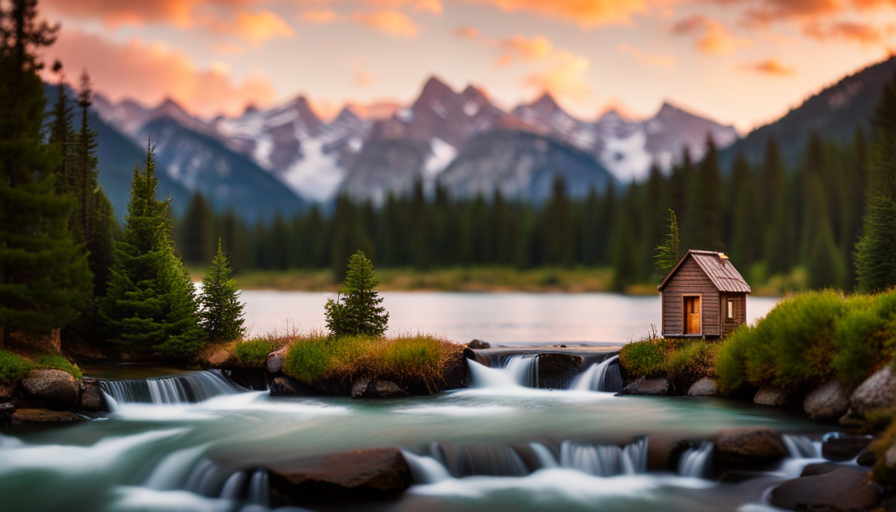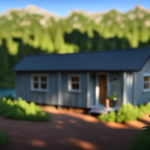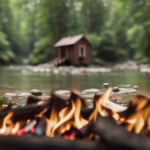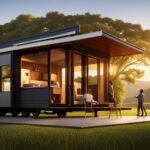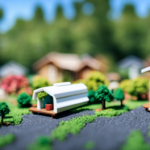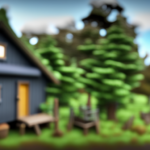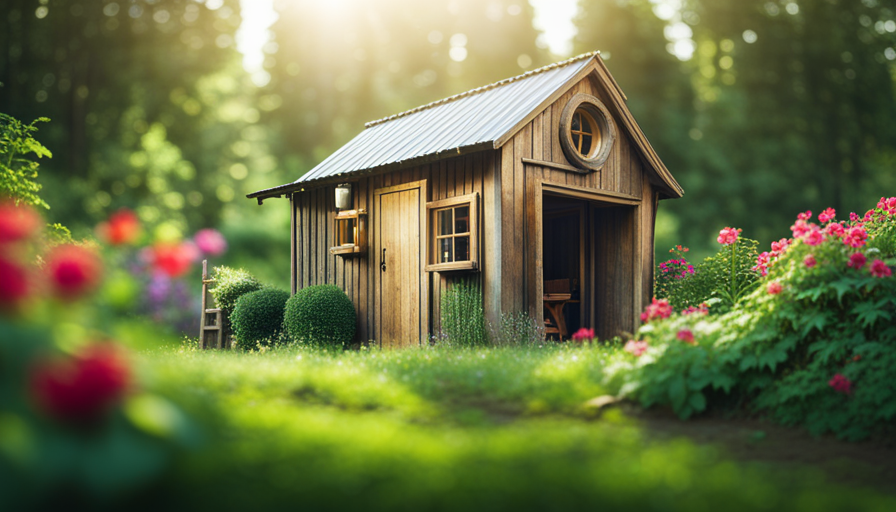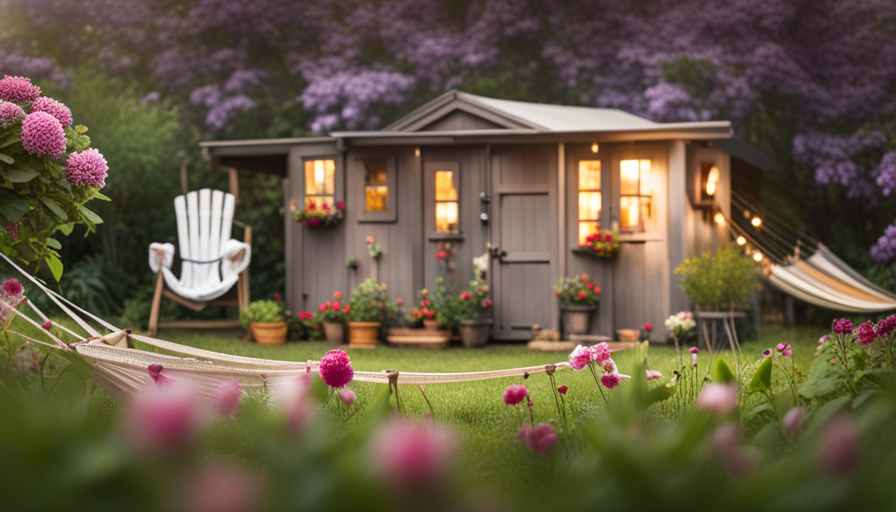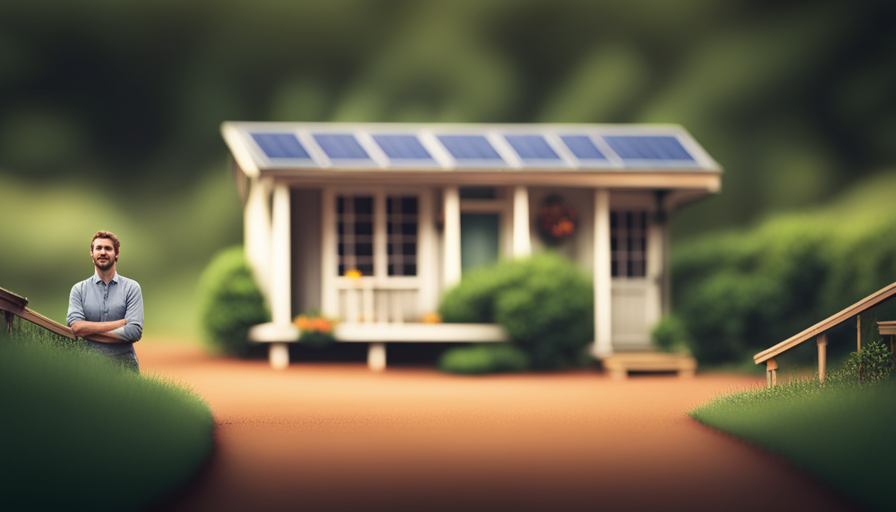Welcome to the world of tiny house living, where less is more and simplicity reigns supreme. Choosing this unique lifestyle is like taking a leap of faith and diving into a sea of possibilities.
Like a nomadic sailor, searching for the perfect wave, I’ve explored the vast expanse of options for where to live in a tiny house. From bustling urban areas to serene rural retreats, and everything in between, the choices are as diverse as the people who choose this way of life.
In this article, we will navigate through the labyrinth of potential dwellings, uncovering hidden gems and uncharted territories. Whether you crave the hustle and bustle of city life or long for the tranquility of a countryside haven, there is a place for you and your tiny abode.
We will delve into the world of tiny house communities, where like-minded individuals come together to create a supportive and sustainable environment. Additionally, we will explore the option of living in your own backyard or family property, as well as the possibility of setting up camp in campgrounds and RV parks.
For those seeking a sense of camaraderie, co-living spaces and college campuses present enticing choices. And if wanderlust calls your name, we will even venture into international locations where tiny house living is gaining momentum.
Join me on this journey as we uncover the myriad of options available to those who dare to downsize and embrace the freedom that comes with living in a tiny house. From the concrete jungle to the tranquil countryside, the world is our oyster, and it’s time to find our tiny pearl.
Key Takeaways
- Tiny house living offers a simpler and more sustainable lifestyle with a smaller ecological footprint.
- Living in urban areas provides easy access to amenities, job opportunities, and a vibrant social scene.
- Living in rural retreats offers tranquility, connection to nature, and a simpler, more sustainable lifestyle.
- Tiny house communities provide a supportive and sustainable environment with shared amenities, socializing opportunities, and learning from others.
Urban Areas
If you’re looking for a bustling and vibrant neighborhood to park your tiny house, urban areas are the way to go! Living in an urban area offers a multitude of benefits, including easy access to amenities and a vibrant social scene. Whether it’s restaurants, shops, or cultural events, urban areas provide a range of options just steps away from your tiny house.
One advantage of living in an urban area is the convenience of having amenities close by. Need groceries? Just walk to the nearest supermarket. Craving a cup of coffee? There’s likely a cozy café around the corner. Urban areas are known for their abundance of amenities, making it easy to find whatever you need without having to travel far.
Another consideration when choosing where to live in a tiny house is the cost of living. Urban areas often have a higher cost of living compared to rural areas, but they also offer more job opportunities and higher salaries. It’s important to weigh the cost of housing and other expenses against the potential career prospects and income growth in urban areas.
Urban areas are an attractive option for those seeking a vibrant and convenient lifestyle. With easy access to amenities and a range of activities, living in an urban area can be exciting and fulfilling. However, if you’re looking for a quieter and more serene setting, the next section will explore rural retreats.
Rural Retreats
When it comes to finding the perfect spot for your cozy little abode, nothing beats the charm and tranquility of the countryside. Rural retreats offer a sense of rural solitude that is hard to find in busy urban areas. Living off the grid in a tiny house in the countryside allows you to disconnect from the hustle and bustle of city life and embrace a simpler, more sustainable lifestyle.
In a rural retreat, you can enjoy breathtaking views, fresh air, and the peaceful sounds of nature. It’s the perfect setting for those seeking a slower pace of life and a closer connection to the natural world. Whether you choose to live in the rolling hills, near a serene lake, or nestled in a dense forest, there are plenty of options for creating your own slice of paradise.
To help you visualize the possibilities, here is a table showcasing some popular rural retreat locations:
| Location | Features | Accessibility |
|---|---|---|
| Mountains | Majestic views, hiking trails | Remote |
| Farmland | Wide open spaces, agriculture | Accessible |
| Lakeside | Serene waters, fishing | Secluded |
| Forest | Tranquil atmosphere, wildlife | Remote |
Living in a rural retreat offers the chance to embrace the beauty of nature and enjoy the peace and quiet of off grid living. However, if you prefer a more communal experience, you may want to consider joining a tiny house community.
Tiny House Communities
Imagine being part of a vibrant community where like-minded individuals come together to embrace a simpler, more sustainable way of life in their compact abodes. Urban tiny house communities offer just that. These communities provide a unique opportunity to live in a tiny house while enjoying the benefits of an urban setting.
With the rising popularity of tiny homes, these communities have sprung up in various cities, offering sustainable living options to those who seek a smaller ecological footprint.
Urban tiny house communities often have shared amenities and common spaces, fostering a sense of camaraderie among residents. These spaces can include community gardens, shared workspaces, and recreational areas, allowing for social interaction and collaboration.
Living in a tiny house community also provides the opportunity to learn from others who have embraced the tiny house lifestyle, sharing tips and tricks for maximizing space efficiency and sustainable living practices.
Transitioning to the subsequent section about backyard or family property, many individuals choose to place their tiny homes on their own property or that of a family member. This allows for the convenience of being close to loved ones while still enjoying the benefits of a tiny house lifestyle.
Backyard or Family Property
Living in a tiny house on your own or a family member’s property allows for a unique sense of closeness and connection, but have you ever considered the long-term implications of this choice? While it may seem like an ideal solution, there are certain factors to consider before making this decision. One of the main considerations is the legality of backyard rentals and zoning regulations. It’s important to verify with your local municipality whether you are allowed to rent out your backyard for a tiny house. Some areas have specific regulations in place that prohibit this type of arrangement, while others may require permits or have restrictions on the size and design of the tiny house. Additionally, you should also think about the impact on your family dynamics and relationships. Living in close quarters with family members can be both rewarding and challenging, so it’s important to have open and honest conversations about expectations and boundaries.
To paint a clearer picture, here is a table highlighting the pros and cons of living in a tiny house on a family property:
| Pros | Cons |
|---|---|
| Close proximity to loved ones | Lack of privacy |
| Shared expenses | Potential conflicts |
| Strong support network | Limited personal space |
Considering these factors, it’s crucial to weigh the benefits and drawbacks of living in a tiny house on a family property before committing to this lifestyle choice. Now, let’s explore another option: campgrounds and RV parks.
Campgrounds and RV Parks
When considering where to live in a tiny house, one option to explore is campgrounds and RV parks. These locations provide access to facilities and services such as electricity, water, and waste disposal.
Additionally, living in a campground or RV park offers opportunities for socializing and networking with other like-minded individuals. Lastly, the flexibility to move and explore different areas is a significant advantage of living in these locations, allowing me to experience new places and meet new people along the way.
Access to facilities and services
With a tiny house, you’ll have convenient access to essential facilities and services, making your daily life more manageable and enjoyable. Living in a tiny house provides you with the opportunity to choose a location that is in close proximity to healthcare facilities, ensuring that medical assistance is easily accessible whenever needed.
Additionally, you can select a tiny house community that is conveniently located near grocery stores, allowing you to easily stock up on supplies and groceries without having to travel long distances.
Furthermore, many tiny house communities offer shared amenities such as laundry facilities, community gardens, and recreational spaces, providing you with a comfortable and convenient living environment. These facilities and services make living in a tiny house not only practical but also enjoyable.
In the subsequent section, we will explore the opportunities for socializing and networking in tiny house communities.
Opportunities for socializing and networking
One important aspect to consider when deciding where to live in a tiny house is the opportunities for socializing and networking. Living in a small space can sometimes feel isolating, so it’s crucial to have access to social clubs and community events. These can provide a sense of belonging and a chance to meet like-minded people who share similar interests. Whether it’s joining a book club, attending local festivals, or participating in community projects, these activities can enrich your social life and create a supportive network of friends. In order to help you visualize the importance of socializing, here is a table showcasing the benefits:
| Benefits of Socializing and Networking |
|---|
| 1. Expanded social circle |
| 2. Opportunities for collaboration |
| 3. Increased sense of belonging |
By immersing yourself in the local community, you can truly make the most of your tiny house living experience. And speaking of making the most of it, let’s explore the flexibility to move and explore different areas.
Flexibility to move and explore different areas
Having the freedom to easily travel and discover new places is one of the greatest advantages of living in a tiny house. The flexibility to work remotely allows me to pick up and move whenever I feel the desire to explore a different area.
With the rise of remote work opportunities, I can take my job with me wherever I go, making it possible to have a constantly changing backyard. Whether it’s waking up to the sound of crashing waves on a secluded beach or enjoying the breathtaking views of a mountain range, the possibilities are endless.
This flexibility not only satisfies my wanderlust but also allows me to immerse myself in different cultures and experiences. As I delve into the world of DIY homesteading, I can’t help but think about the endless opportunities that await me in my next destination.
DIY Homesteading
If you’re looking to create a self-sustainable lifestyle, try your hand at DIY homesteading in your chosen tiny house location. DIY gardening and sustainable living go hand in hand when it comes to living in a tiny house. With limited space, it’s important to make the most of what you have and maximize your resources.
By growing your own food in a DIY garden, you can ensure a steady supply of fresh produce while reducing your carbon footprint. Implementing sustainable practices such as composting, rainwater harvesting, and using renewable energy sources can further enhance your self-sustainability.
DIY homesteading allows you to take control of your own food production and live a more environmentally conscious lifestyle. By growing your own fruits, vegetables, and herbs, you can reduce your reliance on grocery stores and have a direct connection to where your food comes from. This not only provides you with a sense of accomplishment but also ensures that you’re consuming fresh, organic produce that you know is free from harmful pesticides and chemicals.
In addition to the environmental benefits, DIY homesteading can also save you money in the long run. By growing your own food, you can significantly reduce your grocery bills and have the satisfaction of knowing that you’re providing for yourself and your family. It’s a rewarding and fulfilling way to live, and it’s something that can be easily incorporated into your chosen tiny house location.
By embracing DIY homesteading, you can create a self-sustainable lifestyle that allows you to live in harmony with nature and minimize your impact on the environment. It’s just one of the many advantages of living in a tiny house.
Transitioning into the subsequent section about co-living spaces, you can also explore the option of joining a community of like-minded individuals who are passionate about sustainable living.
Co-Living Spaces
Now that we’ve explored the world of DIY homesteading, let’s dive into another option for living in a tiny house: co-living spaces. Co-living spaces are a growing trend for those seeking a sense of community and shared resources while living in a small space.
These spaces often provide not only a place to live but also co-working spaces, where you can work alongside like-minded individuals.
One benefit of co-living spaces is that they often have established relationships with local governments, making it easier to navigate the sometimes murky waters of tiny house regulations. This can save you time and headache when it comes to obtaining the necessary permits and approvals.
When considering a co-living space, there are a few key factors to keep in mind:
-
Location: Look for a co-living space that is convenient to your work or other activities.
-
Amenities: Consider what amenities are important to you, such as communal kitchens, laundry facilities, or outdoor spaces.
-
Community: Take the time to get to know the other residents and ensure that the community aligns with your values and lifestyle.
As we transition to the next section about college campuses, let’s explore how these institutions are embracing the tiny house movement.
College Campuses
When it comes to college campuses, there are several key points to consider. First, access to educational resources and events is often abundant, with libraries, research facilities, and guest speakers readily available.
Additionally, college campuses often offer affordable housing options for students, providing a convenient and cost-effective living situation.
Lastly, campuses provide numerous opportunities for personal and professional growth, with clubs, organizations, internships, and career services all at your fingertips.
Overall, college campuses are a hub of resources and opportunities that can greatly enhance your educational experience.
Access to educational resources and events
Living in a tiny house allows for easy access to a vibrant community full of educational resources and events, enriching your learning experience in unexpected ways.
Educational workshops and community classes are readily available, providing opportunities to expand your knowledge and skills. Whether it’s a cooking class, a DIY workshop, or a lecture on sustainable living, there is always something new to learn and explore. These resources not only enhance your educational experience but also foster a sense of community and connection with like-minded individuals.
Additionally, being part of a college campus provides access to libraries, research facilities, and academic events, giving you access to a wealth of knowledge and expertise.
As you delve into the world of education and learning, you’ll find that living in a tiny house on a college campus offers a unique and enriching experience.
Transitioning to the next section, let’s explore the affordable housing options available in these vibrant communities.
Affordable housing options
Imagine finding a cozy and budget-friendly home that fits your needs perfectly in these vibrant communities. When it comes to affordable housing options for tiny house living, there are a few different routes to consider.
One option is to look for affordable rentals in areas that allow tiny houses. Many cities and towns have zoning regulations that permit accessory dwelling units or tiny homes on wheels. These can be a great way to find a temporary or long-term solution that won’t break the bank.
Another option is to explore housing cooperatives, which are community-owned and operated housing developments. These cooperatives often offer affordable housing options and a sense of community that can be appealing to those looking for a tight-knit neighborhood.
With affordable rentals and housing cooperatives, there are plenty of opportunities to find the perfect tiny house living situation that suits your needs and budget.
As we move on to the next section, we will explore the possibilities for personal and professional growth in these communities.
Opportunities for personal and professional growth
Thriving in these tiny home communities presents plentiful possibilities for personal and professional progress. Living in a tiny house allows for a minimalist lifestyle that encourages personal development and growth. With fewer possessions and distractions, individuals can focus on honing their skills, pursuing their passions, and cultivating a sense of self. Additionally, these communities often offer unique opportunities for career advancement. Collaborative workspaces and networking events allow residents to connect with like-minded individuals and expand their professional networks. Furthermore, the affordability of tiny homes allows individuals to invest more in their education and training, opening doors to new career paths and possibilities. Embracing a tiny home lifestyle not only provides a simpler and more sustainable way of living, but also creates opportunities for personal and professional growth. Transitioning into the subsequent section about ‘mobile lifestyle’, individuals can take their newfound skills and experiences on the road, embracing a mobile lifestyle that offers even more possibilities for exploration and growth.
Mobile Lifestyle
While embracing a mobile lifestyle, one can truly experience the freedom and flexibility of living in a tiny house. Here are four reasons why a mobile lifestyle in a tiny house can offer an extraordinary living experience:
-
Adventure on your doorstep: With a tiny house on wheels, you have the opportunity to explore different locations without the hassle of packing and unpacking. Simply hitch your house to your vehicle, and you’re ready to hit the road, discovering new places and meeting new people.
-
Cost-effective living: A mobile lifestyle in a tiny house presents an affordable housing option. With lower utility bills, reduced maintenance costs, and minimalistic living, you can save money and live a debt-free life. Plus, the flexibility to move means you can find work opportunities in different areas without the burden of high rental or mortgage fees.
-
Minimal environmental impact: Living in a tiny house promotes sustainability as it requires fewer resources to build and maintain. Moreover, the ability to relocate easily means you can minimize your carbon footprint by choosing to live closer to your workplace or utilizing renewable energy sources.
-
Embracing simplicity: A mobile lifestyle in a tiny house encourages a minimalist mindset. It allows you to declutter your life, focusing on experiences rather than material possessions. This freedom from excess can lead to a more fulfilling and balanced life.
By embracing a mobile lifestyle in a tiny house, you can enjoy the benefits of affordability, sustainability, and simplicity. Transitioning to international locations opens up even more opportunities for exploration and growth.
International Locations
Experience the thrill of discovering new cultures and immersing yourself in unique international communities as you traverse the globe in your mobile abode. Living in a tiny house allows you to explore a variety of international locations while enjoying affordable housing options. Whether you dream of waking up to breathtaking views in the Swiss Alps or soaking up the sun on the beaches of Thailand, there are numerous destinations that cater to tiny house living.
To help you choose your next international location, here is a table showcasing five countries that offer affordable housing options for tiny house enthusiasts:
| Country | Cost of Living | Tiny House Community | Visa Requirements |
|---|---|---|---|
| New Zealand | Moderate | Strong | Depends on length |
| Australia | High | Growing | Working holiday |
| Canada | Moderate | Expanding | Working holiday |
| Germany | Moderate | Developing | Schengen visa |
| Costa Rica | Low | Emerging | 90-day tourist |
These international locations not only provide affordable housing options but also offer unique cultural experiences. From the stunning landscapes of New Zealand to the vibrant cities of Germany, tiny house living allows you to fully immerse yourself in the local culture while enjoying the freedom of a mobile lifestyle. So, pack your bags and get ready to explore the world in your tiny house!
Frequently Asked Questions
Are there any legal restrictions or regulations that I need to be aware of when living in a tiny house in urban areas?
Legal restrictions and urban zoning are important considerations when living in a tiny house in urban areas. It’s crucial to research and comply with local regulations to ensure a smooth living experience.
What are the advantages of living in a tiny house in a rural retreat compared to an urban area?
Living in a tiny house in a rural retreat offers several advantages. It provides a peaceful and secluded environment, closer connection to nature, lower cost of living, and the opportunity to join tight-knit tiny house communities like the Spur, Texas or the Lost River Modern Village.
Can you provide some examples of existing tiny house communities and what amenities they offer?
Tiny house communities in urban areas face challenges in finding suitable land. However, there are examples like Pocket Neighborhood in Portland and Boneyard Studios in Washington, D.C. that offer amenities like shared gardens and community spaces.
Is it common for people to live in tiny houses on their own backyard or family property, or is it more common to rent or purchase separate land?
While it may seem appealing to live in a tiny house on your own property, zoning laws can be a challenge. However, the backyard tiny house movement is gaining popularity as more communities relax regulations.
What are the typical costs associated with staying at campgrounds and RV parks in a tiny house? Are there any long-term options available?
The costs associated with staying at campgrounds and RV parks in a tiny house can vary depending on the location and amenities provided. Long-term options are available in some campgrounds and RV parks for those interested in permanent tiny house living.
Conclusion
In conclusion, when it comes to finding the perfect location for your tiny house, there are numerous options to consider.
Urban areas provide convenience and access to amenities, while rural retreats offer tranquility and a connection to nature.
Tiny house communities offer a sense of community and shared resources, while setting up your tiny house in your own backyard or family property allows for familiarity and convenience.
Campgrounds, co-living spaces, college campuses, and even international locations are also worth exploring.
Remember, "Home is where the heart is," so choose a location that speaks to your soul and fits your lifestyle.
Hi, I’m Emma. I’m the Editor in Chief of Tiny House 43, a blog all about tiny houses. While tree houses are often associated with childhood, they can be the perfect adult retreat. They offer a cozy space to relax and unwind, surrounded by nature. And since they’re typically built on stilts or raised platforms, they offer stunning views that traditional homes simply can’t match. If you’re looking for a unique and romantic getaway, a tree house tiny house might just be the perfect option.
